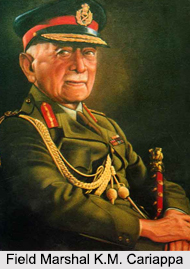 Field Marshal K.M. Cariappa has left an indelible mark on the history of modern India. He played a pioneering role in promoting Indian leaders to assist the Indian Army. This used to be called Indianisation of Indian Army and had been one of the important issues taken up during the freedom struggle. In 1983, he was given the title of the Field Marshal (five stars), the highest honour in the Indian Army.
Field Marshal K.M. Cariappa has left an indelible mark on the history of modern India. He played a pioneering role in promoting Indian leaders to assist the Indian Army. This used to be called Indianisation of Indian Army and had been one of the important issues taken up during the freedom struggle. In 1983, he was given the title of the Field Marshal (five stars), the highest honour in the Indian Army.
Achievements of Field Marshal K.M. Cariappa
Although the Field Marshal had put in 30 years of service, his advance in higher ranks was at a staggering pace. In 1942 he was a Major and barely 6 years later he was Army Commander in 1948 and a year later was Army Chief in 1949. There are many firsts to K.M. Cariappa"s credit, starting from his getting commissioned in 1919 to his taking over as the commander-in-chief in 1949. He was in the first batch of Indian Officers of the Indian Army. He was:
First Indian to qualify at the staff college.
First Indian Commanding Officer in 1942.
First Indian General Officer in 1947.
First Indian Army Commander in 1948.
First Indian Commander-in-Chief in 1949.
Throughout his long and distinguished career in the Army, he showed total dedication to the service and personal integrity of the highest order. In 1947, K.M. Cariappa became the first Indian to go to the U.K. for a training course at the Imperial Defence College.
In 1953, he retired from the Indian Army and served as High Commissioner to Australia and New Zealand till 1956. After his retirement from the Indian Army, he was made the High Commissioner.




















